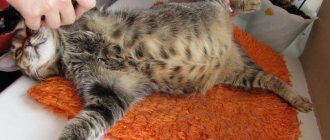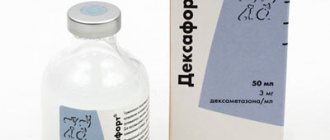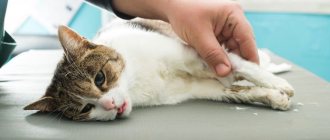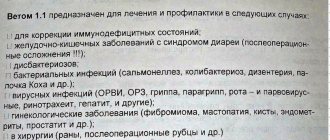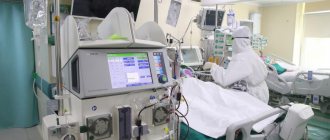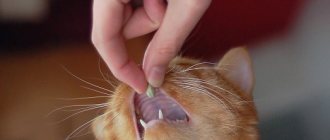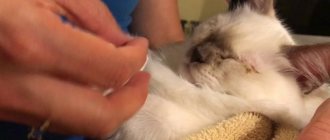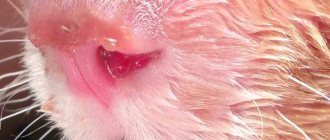general description
The antibacterial agent is produced in the form of an injection solution. The antibiotic is produced by different pharmacological companies, so you can find different packaging in pharmacies. Externally, the solution is transparent, although it has a light yellow tint. It is characterized by a slightly viscous consistency.
For packaging, bottles made of clear or dark glass are used. To maintain tightness, they are sealed with rubber stoppers, which are rolled up with aluminum caps. Bottles come in different sizes: 20, 50 and 100 ml. In most cases, it is wise to buy small bottles for cats.
The active component of the drug is the substance of the same name – tylosin. The antibiotic is available in pharmacies in two versions - Tylosin 50 and Tylosin 200. The only difference is the content of the active substance - 50 and 200 mg per 1 ml of solution, respectively. In both cases, the composition also includes auxiliary components:
- gasoline alcohol;
- purified water;
- propanediol
Note! For cats, it is recommended to use a drug with index “50”. The concentration of the active substance in it is less, and therefore it is easier to calculate the correct dose for a small animal, thereby preventing an overdose.
There is no need to observe special conditions when storing the drug. The air temperature should be between 10 and 25˚C. After opening the bottle, the injection solution can only be used for 28 days, after which it must be disposed of.
Pharmacological properties
Tylosin has pronounced antibacterial properties. The drug, developed specifically for animals, is effective against the following types of pathogenic microorganisms:
- hemophilus influenzae infections;
- streptococci;
- staphylococcus;
- mycoplasma;
- Leptospira;
- chlamydia;
- pasteurella;
- corynobacteria, etc.
The principle of action of the active substance is to block bacterial protein synthesis. The antibiotic is quickly absorbed and just an hour after injection its concentration in tissues reaches its maximum value. The effect of the medicine lasts for 20-24 hours. Tylosin is excreted from the body primarily through bile and urine. In lactating animals, the active substance can penetrate into the milk.
Based on the degree of impact, the drug is classified as a low-hazard substance. If the recommended doses and dosage regimen are followed, it is well tolerated by animals and does not cause local irritant reactions or addiction.
Tylosin 50, 200
Advantages
Tylosin base is more stable and effective than tylosin tartrate.
One of the safest antibiotics
Well tolerated
Cost-effective cost of treatment
Short terms of restrictions on meat and milk
Description
A traditional medicinal product with a patented technology for producing tylosin as a base for the treatment of animals with diseases of bacterial etiology, a leader in sales among injectable macrolide antibiotics.
Tylosin 50 and 200 are a clear, slightly viscous, light yellow liquid.
Available in the form of 5% and 20% sterile injection solution in glass bottles of 20, 50 and 100 ml.
Compound
1 ml TYLOSIN 50 TILOSIN 200 = 50 mg and 200 mg tylosin respectively
Pharmacological properties
Tylosin for animals is an antibacterial drug of the macrolide group. Tylosin acts on gram-positive and some gram-negative bacteria, including: streptococci, staphylococci, leptospira, corynebacteria, clostridia, erysepilothrix, pasteurella, chlamydia, spirochetes and mycoplasma. When administered intramuscularly, the antibiotic is rapidly resorbed and reaches maximum tissue concentrations approximately 1 hour after administration. The therapeutic level of the antibiotic remains in the body for 20-24 hours. It is excreted from the body mainly with urine and bile secretions, in lactating animals and with milk. According to the degree of impact on the body, it is classified as a low-hazard substance.
Indications for use
Tylosin 50 and 200 are used for the prevention and treatment of infectious diseases caused by pathogens sensitive to tylosin, as well as for the prevention and treatment of secondary infections in viral diseases.
Cattle, calves: pneumonia, mastitis, enteritis, secondary infections due to viral diseases.
Pigs: enzootic pneumonia, arthritis, dysentery, secondary infections due to viral diseases, atrophic rhinitis, swine erysipelas, etc.
Sheep, goats: infectious agalactia of sheep and goats, pneumonia of goats, etc.
Dosage and method of administration
The drug is administered only intramuscularly once a day. When repeated use, it is necessary to change the injection site. Recommended doses per 1 kg of animal body weight:
Directions for use (doses)
As a rule, no side effects are observed when using Tylosin. With increased individual sensitivity, allergic reactions are possible in some animals. In pigs, erythema, itching and respiratory symptoms are very rare. These reactions go away very quickly without intervention. As a sole measure, depending on the circumstances, it is possible to recommend discontinuation of drug treatment. The duration of use should not exceed 3 days.
Restrictions Slaughter of animals for meat is permitted no earlier than 8 days after the last use of Tylosin. Meat from animals forcedly killed before the expiration of the specified period can be used as animal feed. Milk from dairy animals may be used for food purposes within 4 days after the last administration of the drug. Milk obtained during the treatment period and within 4 days after the last administration of the drug is prohibited from being used for food purposes; it can be used to feed animals.
Price
When purchasing Tylosin 50 for cats, please note that the price depends on the volume of the package:
- 20 ml – 48-60 rub.;
- 50 ml – 115-130 rub.;
- 100 ml – 140-180 rub.
The cost of Tylosin 200 is slightly higher. For a bottle with a capacity of 20 ml you will have to pay about 85-90 rubles, and a package of 50 ml - 150-160 rubles. You can buy the medicine at any veterinary pharmacy or clinic. The antibiotic is also available in many online pharmacies for animals.
You can now view the current price of the drug and buy it right here:
Composition and release form of the drug (50-200)
Tylosin is a broad-spectrum antibiotic.
The main active component of the drug is the substance tylosin, which actively interacts with ribosomes, which allows you to quickly and effectively suppress the vital activity of most microorganisms. In veterinary pharmacies there are drugs with different dosages:
- 50 mg;
- 200 mg.
The drugs differ only in the dosage of the active component. If desired, you can purchase an antibiotic packaged in dark bottles of 20, 50 or 200 ml.
Indications for use
According to the instructions for use, Tylosin is prescribed to cats for the treatment of the following pathologies:
- pneumonia;
- tracheitis;
- bronchitis;
- other diseases of the respiratory system;
- arthrosis and arthritis;
- inflammatory processes of the genitourinary system, in particular mastitis;
- mycoplasmosis;
- chlamydia;
- dysentery, etc.
The drug is also used for secondary infections that accompany viral diseases. Sometimes an antibiotic is prescribed for purulent wounds and inflammatory processes caused by harmful microorganisms.
Indications for use in cats
As mentioned above, the range of uses of Tylosin is extremely wide. It is successfully prescribed for:
- all kinds of bacterial diseases of the respiratory system, ranging from bronchitis to pneumonia;
- diseases of the reproductive organs, for example, in the case of mastitis;
- development of secondary infections or complications;
- dysentery;
- arthritis and arthrosis.
In addition to all of the above, the drug can be prescribed in a number of other cases, for example, Tylosin is prescribed for mycoplasmosis.
Instructions for use
Animals are given injections of antibacterial agents only intramuscularly. Subcutaneous administration of the drug can cause inflammation and necrosis at the injection site. According to the instructions for use, the dosage of Tylosin 50 for cats is calculated taking into account weight - 0.1-0.2 ml per 1 kg of weight. The exact dose must be determined by the doctor, taking into account the degree of development of the disease, existing symptoms, possible complications and other factors. Tylosin 200 for cats is rarely used due to the high concentration of the active substance, but if for some reason it is used, the dosage is calculated as follows - 0.025-0.05 ml per 1 kg of weight.
Injections of the drug should be done once a day. The duration of treatment is from 3 to 7 days, depending on the symptoms and severity of the disease. It is not recommended to skip injections, as this leads to a decrease in the effectiveness of the antibacterial agent.
Note! You need to inject the medicine for the entire course prescribed by the doctor. You should not stop treatment if the animal’s condition improves. In this case, the risk of re-development of the pathology or the appearance of complications increases.
Dosing of the drug
- The dose of tylosin is 200 in dogs - 0.025-0.05 ml/kg body weight.
- The dose of tylosin-50 for dogs is 0.1-0.2 ml/kg body weight.
Tylosin-50 is a special antibacterial substance that is primarily used to fight bacterial infection in dogs and other animal species. This substance is synthesized by microbes - Actinomycetes and Streptomyces fradiae; it is a macrolide antibiotic used to treat diseases in dogs that cannot be treated with other methods.
It is important to note that Tylosin is not FDA approved for use in pets, but it is a prescription drug that can be purchased legally from veterinarians and is best used as directed by a veterinarian.
We invite you to familiarize yourself with the Features of treating bees with Bipin with kerosene
Contraindications and side effects
The antibiotic is prohibited for animals that have an individual intolerance to the components, in particular tylosin. In this case, it is worth choosing another antibacterial agent for treatment.
The drug should be taken with caution for lactating animals. The active substance can penetrate into milk, and with it into the body of kittens. Sometimes this leads to severe dysbiosis, which can manifest itself as loose stools and other unpleasant symptoms. In each case, the risk for kittens and mother is assessed individually. The medicine should only be used in nursing cats under the supervision of a physician.
Note! Tylosin should absolutely not be combined with penicillin antibiotics and other antibacterial agents. In this case, the risk of allergic reactions increases.
If intolerance occurs, respiratory diseases, itching, redness and other allergic reactions may occur. To prevent them, the antibiotic is combined with anti-allergenic drugs (Tavegil, Suprastin, Diazolin, etc.). In rare cases, loose stools or other gastrointestinal disturbances may occur. In most cases, the drug is well tolerated by cats and does not cause side effects.
Advantages and disadvantages
Tylosin is considered one of the safest antibiotics for animals, and cats in particular. It was designed with pets in mind. Its main advantages include the following:
- High efficiency.
The animal feels better after 1-2 injections. - Wide spectrum of action.
The drug can be used for diseases of the respiratory, genitourinary and other systems, the musculoskeletal system, and suppuration of soft tissues. The active substance acts on various harmful bacteria. - Packaging volumes.
It is easy to select a bottle, taking into account the duration of treatment, the weight of the animal and other factors. - Minimum contraindications.
The drug is approved for use in cats of different ages and breeds. - Safety.
If the recommended doses are followed, side effects rarely occur.
The disadvantages include the need to do intramuscular injections. If you have no experience, you will have to take your pet to the clinic every day, and this can cause stress. Tylosin has no other significant disadvantages, but you should not use it without a doctor’s prescription.
Owner reviews
Lyuba, owner of a British cat:
“We were prescribed Tylosin to treat pneumonia in a cat. We went to the clinic for injections every day (5 times), since I do not know how to give intramuscular injections. Additionally, the cat was given Suprastin to prevent allergies. The results of the treatment were visible within two days. We noticed no side effects."
Victoria, owner of 2 cats:
“For us, Tylosin caused severe chronic diarrhea in two cats. The drug was used to treat chlamydia. Chlamydia was cured, but for a long time they could not get rid of diarrhea. I had to completely change the diet and take feed additives with lactobacilli for a long time. The veterinarian suggested that the cause of loose stool was dysbacteriosis. This was not observed with Baytril.”
